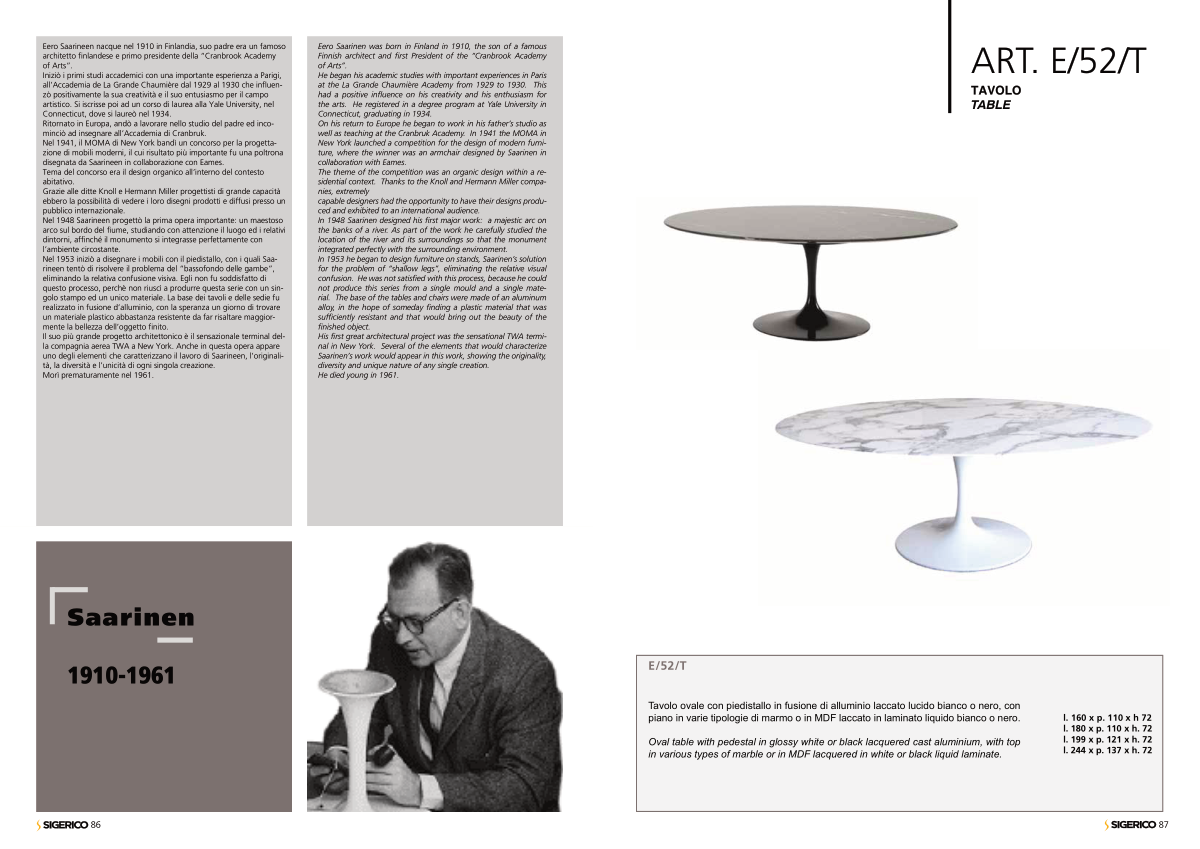Saarinen
1910-1961
Eero Saarineen nacque nel 1910 in Finlandia, suo padre era un famoso
architetto finlandese e primo presidente della “Cranbrook Academy
of Arts”.
Iniziò i primi studi accademici con una importante esperienza a Parigi,
all’Accademia de La Grande Chaumière dal 1929 al 1930 che influen-
zò positivamente la sua creatività e il suo entusiasmo per il campo
artistico. Si iscrisse poi ad un corso di laurea alla Yale University, nel
Connecticut, dove si laureò nel 1934.
Ritornato in Europa, andò a lavorare nello studio del padre ed inco-
minciò ad insegnare all’Accademia di Cranbruk.
Nel 1941, il MOMA di New York bandì un concorso per la progetta-
zione di mobili moderni, il cui risultato più importante fu una poltrona
disegnata da Saarineen in collaborazione con Eames.
Tema del concorso era il design organico all’interno del contesto
abitativo.
Grazie alle ditte Knoll e Hermann Miller progettisti di grande capacità
ebbero la possibilità di vedere i loro disegni prodotti e diffusi presso un
pubblico internazionale.
Nel 1948 Saarineen progettò la prima opera importante: un maestoso
arco sul bordo del fiume, studiando con attenzione il luogo ed i relativi
dintorni, affinché il monumento si integrasse perfettamente con
l’ambiente circostante.
Nel 1953 iniziò a disegnare i mobili con il piedistallo, con i quali Saa-
rineen tentò di risolvere il problema del “bassofondo delle gambe”,
eliminando la relativa confusione visiva. Egli non fu soddisfatto di
questo processo, perchè non riuscì a produrre questa serie con un sin-
golo stampo ed un unico materiale. La base dei tavoli e delle sedie fu
realizzato in fusione d’alluminio, con la speranza un giorno di trovare
un materiale plastico abbastanza resistente da far risaltare maggior-
mente la bellezza dell’oggetto finito.
Il suo più grande progetto architettonico è il sensazionale terminal del-
la compagnia aerea TWA a New York. Anche in questa opera appare
uno degli elementi che caratterizzano il lavoro di Saarineen, l’originali-
tà, la diversità e l’unicità di ogni singola creazione.
Morì prematuramente nel 1961.
Eero Saarinen was born in Finland in 1910, the son of a famous
Finnish architect and first President of the “Cranbrook Academy
of Arts”.
He began his academic studies with important experiences in Paris
at the La Grande Chaumière Academy from 1929 to 1930. This
had a positive influence on his creativity and his enthusiasm for
the arts. He registered in a degree program at Yale University in
Connecticut, graduating in 1934.
On his return to Europe he began to work in his father’s studio as
well as teaching at the Cranbruk Academy. In 1941 the MOMA in
New York launched a competition for the design of modern furni-
ture, where the winner was an armchair designed by Saarinen in
collaboration with Eames.
The theme of the competition was an organic design within a re-
sidential context. Thanks to the Knoll and Hermann Miller compa-
nies, extremely
capable designers had the opportunity to have their designs produ-
ced and exhibited to an international audience.
In 1948 Saarinen designed his first major work: a majestic arc on
the banks of a river. As part of the work he carefully studied the
location of the river and its surroundings so that the monument
integrated perfectly with the surrounding environment.
In 1953 he began to design furniture on stands, Saarinen’s solution
for the problem of “shallow legs”, eliminating the relative visual
confusion. He was not satisfied with this process, because he could
not produce this series from a single mould and a single mate-
rial. The base of the tables and chairs were made of an aluminum
alloy, in the hope of someday finding a plastic material that was
sufficiently resistant and that would bring out the beauty of the
finished object.
His first great architectural project was the sensational TWA termi-
nal in New York. Several of the elements that would characterize
Saarinen’s work would appear in this work, showing the originality,
diversity and unique nature of any single creation.
He died young in 1961.
ART. E/52/T
TAVOLO
TABLE
Tavolo ovale con piedistallo in fusione di alluminio laccato lucido bianco o nero, con
piano in varie tipologie di marmo o in MDF laccato in laminato liquido bianco o nero.
Oval table with pedestal in glossy white or black lacquered cast aluminium, with top
in various types of marble or in MDF lacquered in white or black liquid laminate.
l. 160 x p. 110 x h 72
l. 180 x p. 110 x h. 72
l. 199 x p. 121 x h. 72
l. 244 x p. 137 x h. 72
87
86
E/52/T


